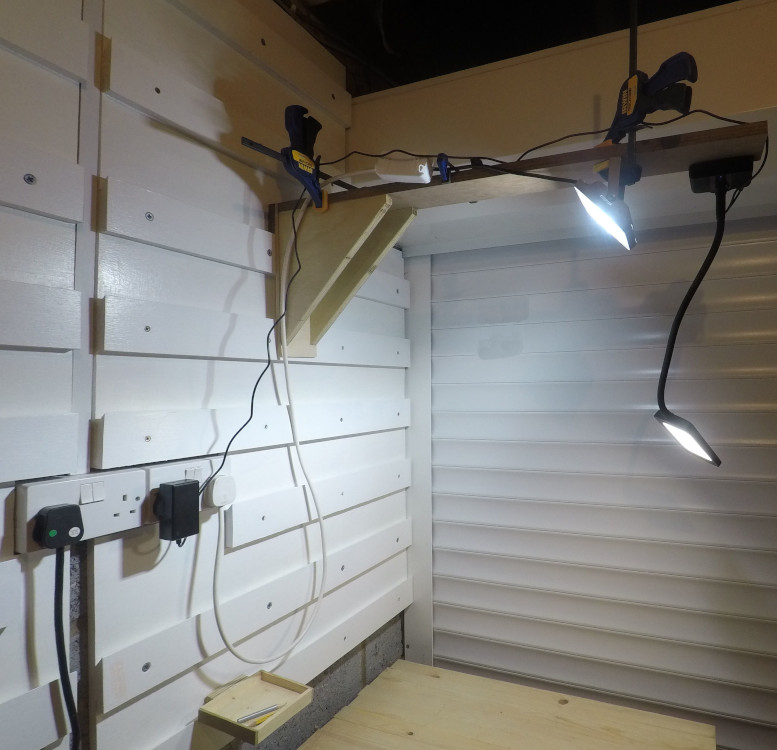Wend
Established Member
Hi folks,
It will probably not shock you to hear that I have a collection of homeless tools and clamps which migrate between my workbench, router table and various bits of floor, to make room for whatever I'm trying to do at any given moment. However, above the router table and workbench is this piece of wall:

So my plan is to convert that into a tool wall - ideally without acquiring too many more tools in the process! It's about 1.6m wide by 1.5m tall. A handful of planes and some clamps are the heaviest things I plan to keep on it. I've read what I could find on this site, and watched some videos on youtube, and come up with a plan that I think will work.
Unfortunately, while I know very little about woodworking, I know even less about DIY, so I thought I'd run this by you and see if this sounds sane?
I'll start off by screwing some 1"x1"s to the wall in a pattern like

I have some brown rawl plugs that say they'll take up to 45mm of no10-no14 screws (which looks like 5-6 in modern sizes), so I was thinking of getting a pack of general purpose 5x70mm screws and using three per piece of 1x1. I don't see any advantage in also attaching the 1x1s to each other.
Does that sound strong enough? Do I need to worry about the wall (and hence the 1x1s) not being flat?
Then on top of that, a sheet of 12mm plywood. If I glue a couple of blocks of wood at the top of the back, then I should be able to use those to hang the sheet on the top 1x1s while I screw it on to the 1x1s, with three 30mm wood screws for each 1x1.
I think that this 2-step process will be easier to do than to try to attach the plywood directly to the wall, and will also mean that the plywood will be able to go over the electrical trunking.
Would that be strong enough? And would the cheaper "hardwood external grade" plywood be OK, or should I go for "marine grade"?
Finally, some 18mm plywood, cut into 100mm strips, then cut in half at 45 degrees on the bandsaw to make some french cleats about 60mm tall, glued to the plywood sheets at about 150mm intervals. I'm guessing this needs to be marine grade, or there may be inconvenient voids.
Should the bandsaw produce good enough cuts for this? And do those sizes/spacings sound sensible?
Thanks in advance for any advice.
Wend
It will probably not shock you to hear that I have a collection of homeless tools and clamps which migrate between my workbench, router table and various bits of floor, to make room for whatever I'm trying to do at any given moment. However, above the router table and workbench is this piece of wall:

So my plan is to convert that into a tool wall - ideally without acquiring too many more tools in the process! It's about 1.6m wide by 1.5m tall. A handful of planes and some clamps are the heaviest things I plan to keep on it. I've read what I could find on this site, and watched some videos on youtube, and come up with a plan that I think will work.
Unfortunately, while I know very little about woodworking, I know even less about DIY, so I thought I'd run this by you and see if this sounds sane?
I'll start off by screwing some 1"x1"s to the wall in a pattern like

I have some brown rawl plugs that say they'll take up to 45mm of no10-no14 screws (which looks like 5-6 in modern sizes), so I was thinking of getting a pack of general purpose 5x70mm screws and using three per piece of 1x1. I don't see any advantage in also attaching the 1x1s to each other.
Does that sound strong enough? Do I need to worry about the wall (and hence the 1x1s) not being flat?
Then on top of that, a sheet of 12mm plywood. If I glue a couple of blocks of wood at the top of the back, then I should be able to use those to hang the sheet on the top 1x1s while I screw it on to the 1x1s, with three 30mm wood screws for each 1x1.
I think that this 2-step process will be easier to do than to try to attach the plywood directly to the wall, and will also mean that the plywood will be able to go over the electrical trunking.
Would that be strong enough? And would the cheaper "hardwood external grade" plywood be OK, or should I go for "marine grade"?
Finally, some 18mm plywood, cut into 100mm strips, then cut in half at 45 degrees on the bandsaw to make some french cleats about 60mm tall, glued to the plywood sheets at about 150mm intervals. I'm guessing this needs to be marine grade, or there may be inconvenient voids.
Should the bandsaw produce good enough cuts for this? And do those sizes/spacings sound sensible?
Thanks in advance for any advice.
Wend







































